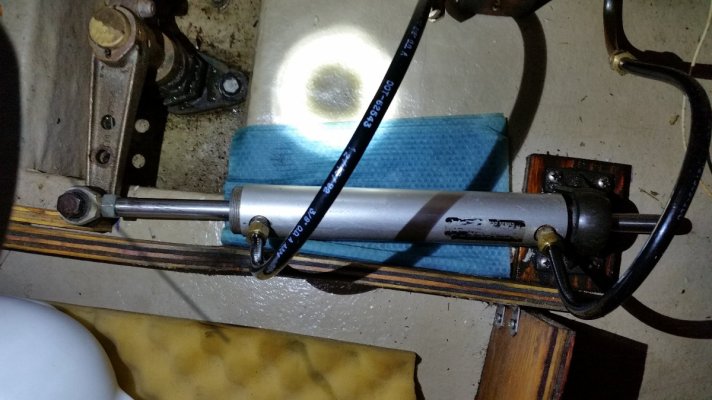Lou_tribal
Guru
Hello,
I am a proud new owner of a 30' custom built trawler and I recently found out that the hydraulic steering cylinder is leaking a bit.
I would like to fix this by changing the current cylinder by a new one and see afterward if the current cylinder can be rebuilt.
Regarding this work to be done, as a newbie I have some questions:
1. Can replacing a cylinder be done while the boat is in the water, I guess so but I would like to be sure before taking everything apart and realizing I am doing something wrong.
2. I cannot determine what is the model of my current cylinder as the sticker on it as been damaged by the time. I know that the steering wheel is 6 turn end to end and I suspect the cylinder to be (or be very similar) to a teleflex HC5314 (seastar BA150-7ATM). What should I check to be sure it will fit before ordering the part?
3. Currently my cylinder is fitted using copper pipe. All the pipe for hydraulic fluid are copper and are fitted directly onto the cylinder. I would personally say that it is not the best as it is creating a solid rigid coupling and I would be enclined to better use flexible hose for the coupling between the copper pipe and the cylinder. What do you think about that?
4. Do you have any recommendation for me before I start this? I would say I am quite handy and I like to do things by myself so I am not scared to do it, I just want to do the right thing once and for all
Many thanks for your time and answers.
I am a proud new owner of a 30' custom built trawler and I recently found out that the hydraulic steering cylinder is leaking a bit.
I would like to fix this by changing the current cylinder by a new one and see afterward if the current cylinder can be rebuilt.
Regarding this work to be done, as a newbie I have some questions:
1. Can replacing a cylinder be done while the boat is in the water, I guess so but I would like to be sure before taking everything apart and realizing I am doing something wrong.
2. I cannot determine what is the model of my current cylinder as the sticker on it as been damaged by the time. I know that the steering wheel is 6 turn end to end and I suspect the cylinder to be (or be very similar) to a teleflex HC5314 (seastar BA150-7ATM). What should I check to be sure it will fit before ordering the part?
3. Currently my cylinder is fitted using copper pipe. All the pipe for hydraulic fluid are copper and are fitted directly onto the cylinder. I would personally say that it is not the best as it is creating a solid rigid coupling and I would be enclined to better use flexible hose for the coupling between the copper pipe and the cylinder. What do you think about that?
4. Do you have any recommendation for me before I start this? I would say I am quite handy and I like to do things by myself so I am not scared to do it, I just want to do the right thing once and for all
Many thanks for your time and answers.




